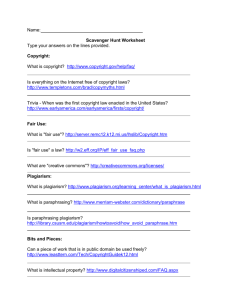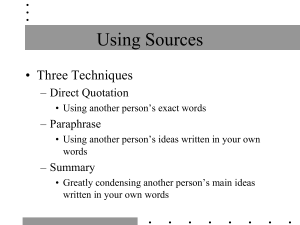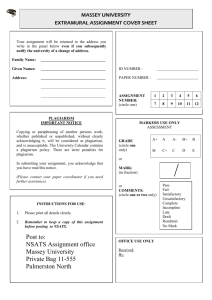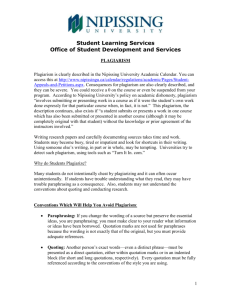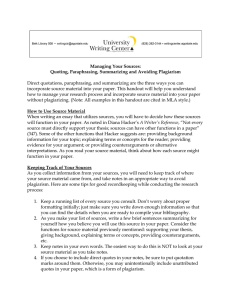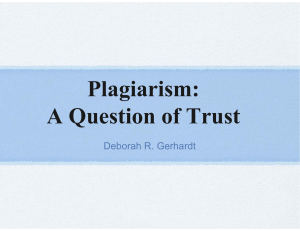Slide Presentation -- Using the Work of Others
advertisement
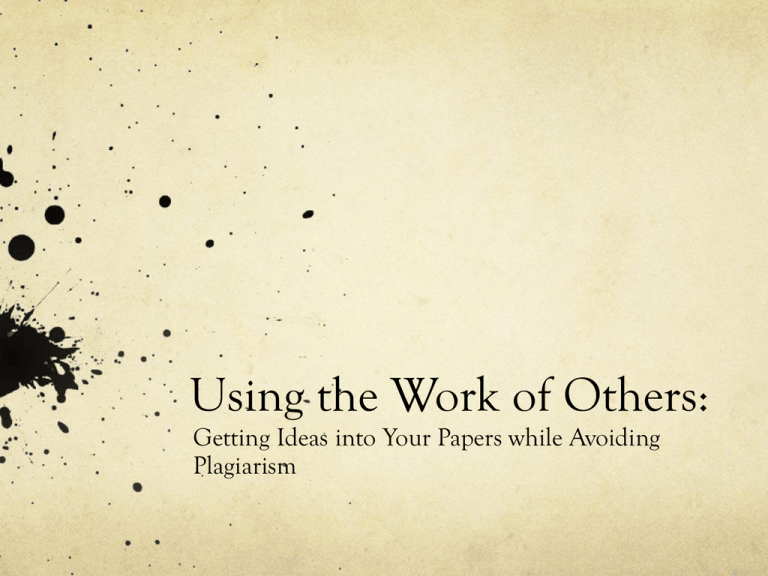
Using the Work of Others: Getting Ideas into Your Papers while Avoiding Plagiarism Agenda Using the Work of Others: Summarizing Paraphrasing Direct quotations Combination of above Recognizing plagiarism Types of plagiarism Checklist for avoiding plagiarism Summarizing Summarizing is distilling a passage or text to its main points, in your own words. A summary should state the main ideas in a passage using as few words as possible. Use summary to digest the core of what a writer is saying, without examples or evidence. Summarizing Gladwell, Malcolm, “Big and Bad: How the S.U.V. Ran over Automotive Safety,” The New Yorker 12 January 2004: 31. The S.U.V. boom represents, then, a shift in how we conceive of safety— from active to passive. It’s what happens when a larger number of drivers conclude, consciously or otherwise, that the extra thirty feet that the TrailBlazer takes to come to a stop don’t really matter, that the tractor-trailer will hit them anyway, and that they are better off treating accidents as inevitable rather than avoidable. The popularity of SUVs indicates a change in how we approach keeping ourselves safe. Being safe is no longer a proactive activity, but instead a defensive response to the unavoidable. Paraphrasing o o o o o Paraphrasing is a close restatement of the author’s “original presentation,” in your own words. Paraphrase is most useful when you want to follow an author’s thinking or reasoning without directly quoting. Read passage several times to understand it. Restate in your own words and sentence structure. Select what is pertinent and restate. Don’t distort original meaning of text! Paraphrasing In Europe and Japan, people think of a safe car as a nimble car. Paraphrase In other parts of the world, safety and maneuverability are synonymous. In the history of the automotive industry, few things have been quite as unexpected as the rise of the S.U.V. Paraphrase The S.U.V.’s ascent is one of the more surprising events in the car industry's nearly 130 years. Direct Quotation Use direct quotation only when the exact words of the original are important. In papers analyzing primary sources such as literary works, you will use it extensively. Tests (when original satisfies one of following) Language is unusually vivid, bold or inventive Quotation cannot be paraphrased without distortion of meaning or loss of meaning. Words themselves are at issue in your interpretation Quotation is a graph, diagram, or table. Combination Learned helplessness is now thought to play a role in such phenomena as depression and the failure of battered women to leave their husbands, but one could easily apply it more widely. We live in an age, after all, that is strangely fixated on the idea of helplessness: we’re fascinated by hurricanes and terrorist acts and epidemics like SARS—situations in which we feel powerless to affect our own destiny. Combination Gladwell reminds us that the concept of learned helplessness is used to help answer difficult questions, such as why people don't leave abusive relationships. However, he also suggests it can be used in a broader context: "We live in an age, after all, that is strangely fixated on the idea of helplessness: we’re fascinated by hurricanes and terrorist acts and epidemics like SARS—situations in which we feel powerless to affect our own destiny." Recognizing Plagiarism Exercise Compare each attempt to quote or paraphrase the passage. Which, if any are plagiarized, inaccurate, or both, and which are acceptable? Why? Types of Plagiarism: Deliberate Plagiarism Copying a phrase, sentence, or longer passage from a source and passing it off as your own Summarizing or paraphrasing someone else's ideas without acknowledging your debt Handing in a paper you bought, had a friend write, or copied from another student Types of Plagiarism: Accidental Plagiarism Forgetting to place quotation marks around another's words Omitting a source citation for another's idea because you are unaware Carelessly copying a source which you mean to paraphrase Avoiding Plagiarism Checklist What type of source are you using: your own independent material, common knowledge, or someone else’s independent material? You must acknowledge someone else’s material. If you are quoting someone else’s material, is the quotation exact? Are graphs, statistics, and other borrowed material identical to source? Omissions with ellipsis and additions with brackets? Have you used your own words and sentence structure when paraphrasing or summarizing? Have you represented the author’s meaning without distortion? Is each use of someone else’s material acknowledged in your text? Are your citations complete and accurate? Does your works cited list include all sources listed in your paper?
